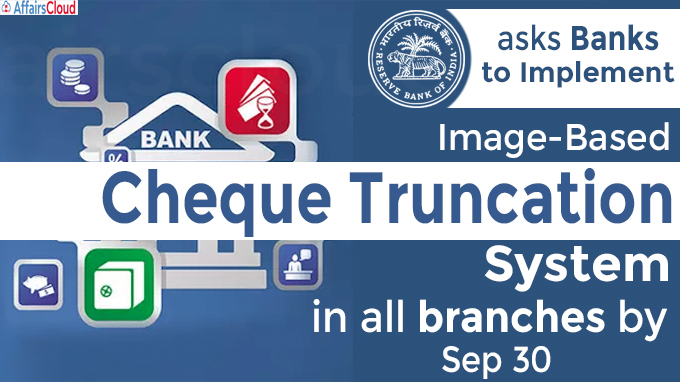 On March 15, 2021, the Reserve Bank of India (RBI) the apex monetary institution asked all the banks in India to implement the image-based Cheque Truncation System (CTS) under respective grids in all its branches by September 30, 2021, to faster the settlement of cheques resulting in better customer service.
On March 15, 2021, the Reserve Bank of India (RBI) the apex monetary institution asked all the banks in India to implement the image-based Cheque Truncation System (CTS) under respective grids in all its branches by September 30, 2021, to faster the settlement of cheques resulting in better customer service.
- About 18,000 bank branches are still outside any formal clearing arrangement hence, it is proposed to bring all such branches under the CTS image-based clearing mechanism by September 2021.
Pan-India Coverage of CTS:
- On February 5, 2021, RBI had announced Pan-India coverage of CTS by bringing all branches of banks in the country under an image-based CTS clearing mechanism.
- Now the banks have been asked to inform the RBI, the roadmap to achieve Pan-India coverage of CTS, and submit a status report before April 30, 2021.
Background:
Cheque Truncation System (CTS) is an online image-based cheque clearing system undertaken by the RBI for faster clearing of cheques by transferring the electronic image of the cheque with vital essential data.
- First implemented in National Capital Region, New Delhi with ten pilot banks on 1st February 2008 and launched in Chennai on 24 September 2011
- After migration from MICR to CTS the traditional MICR-based cheque processing was discontinued and from 1 August 2013, only ‘CTS-2010’ standard cheques compliant cheques were accepted for clearing.
CTS mechanism:
i.Presenting Bank (Represents Payee as it is the bank where the payee holds an account)
- They will capture the data (on the MICR band) and the images of a cheque using their Capture System sends the data and captured images duly signed digitally and encrypted to the clearinghouse. To ensure security, safety end-to-end Public Key Infrastructure (PKI) has been implemented in CTS.
ii.The Clearing House (It acts as a link between both presenting and paying bank)
- It processes the data, arrives at the settlement figure, and routes the images and requisite data to the paying banks.
iii.Paying Bank(Represents Drawee as it is the bank where the payer holds an account )
- They will receive the images and data from the Clearing House for payment processing.
- If the cheque is being rejected for some reason, the paying bank returns the data to the clearinghouse and they will send it to Presenting Bank for verifying the data.
Highlights of CTS Cheques:
- All CTS cheques hold a watermark, with ‘CTS-INDIA’, which is visible when held against any light source
- Pantograph (wavelike design) with hidden/embedded word ‘VOID’ become visible in photocopies of a cheque
- Reserve Bank of India set processing charges of Rs.1.50 per cheque (`0.50 from the presenting bank and `1.00 from the drawee bank).
Recent Related News:
On September 25, 2020, the Reserve Bank of India (RBI) has issued a directive under Section 10 (2) read with Section 18 of Payment and Settlement Systems Act, 2007 (Act 51 of 2007) stating an introduction of a Positive Pay System for Cheque Truncation System (CTS) for banks to check fraud.
About Reserve Bank of India (RBI):
Key Appointments in RBI – Appointments Committee of the Cabinet (ACC) headed by the Prime Minister appoints the governor and deputy governors.
Section 7 in The RBI Act, 1934, empowers the government to issue directions to the RBI governor in the public interest
Shaktikanta Das – 25th governor of the Reserve Bank of India from 11 December 2018




